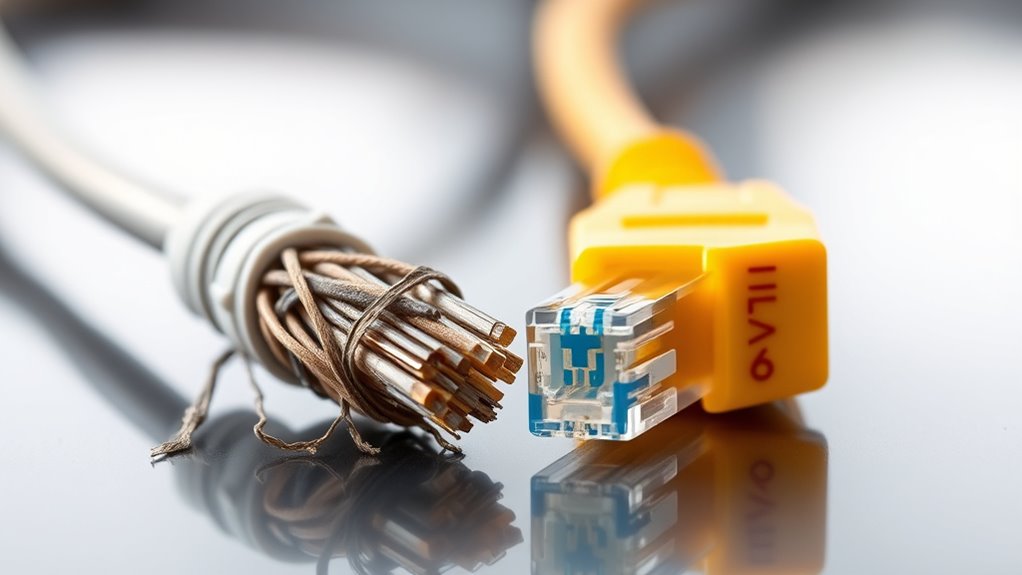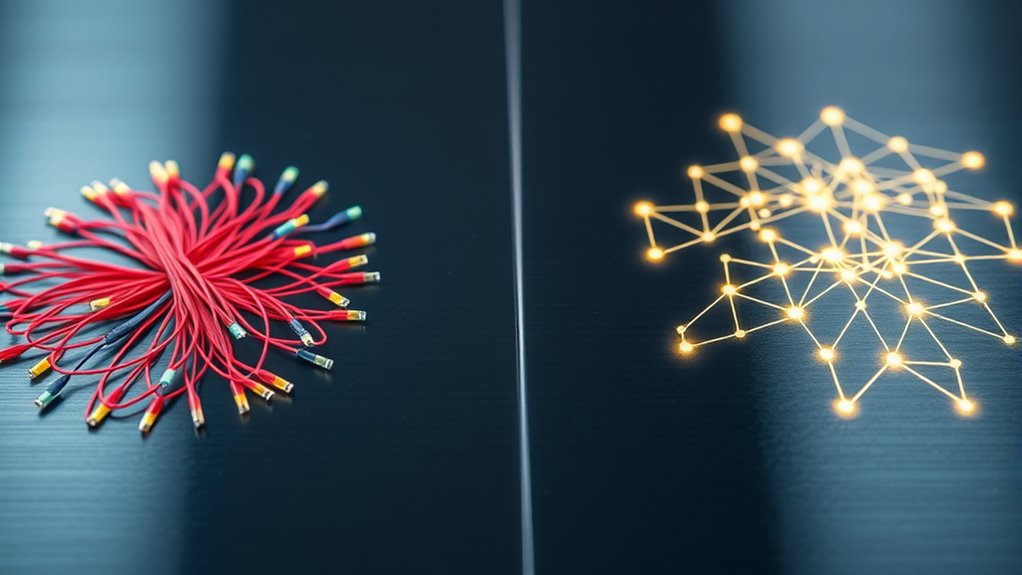IPv4 and IPv6 are two types of internet addresses that help your devices connect online. IPv4 is older and has a limited number of addresses, which can cause shortages. IPv6 is newer and provides many more addresses, making it ideal for the growing number of internet-connected gadgets. With IPv6, networks are easier to manage and more secure. If you keep exploring, you’ll discover how these differences impact your internet experience now and in the future.
Key Takeaways
- IPv4 uses 32-bit addresses, supporting about 4.3 billion devices, while IPv6 uses 128-bit addresses for virtually unlimited devices.
- IPv4 addresses are limited, leading to solutions like NAT; IPv6 eliminates this need with its vast address space.
- IPv4 relies on external security features, whereas IPv6 includes built-in security like mandatory IPsec support.
- IPv4 is still widely used, but IPv6 simplifies network management and supports future growth.
- Transition from IPv4 to IPv6 is ongoing, with IPv6 offering better scalability, security, and efficiency.

Have you ever wondered how the internet keeps up with the growing number of devices? It’s a good question because, as more gadgets connect to the web, the underlying systems need to adapt. One way they do this is through the use of different IP versions, mainly IPv4 and IPv6. IPv4 has been around since the early days of the internet, providing the addresses that identify devices online. However, with over 4 billion addresses, IPv4 started to run out as the world’s connectivity exploded. That’s where IPv6 comes in, offering a much larger pool of addresses to accommodate billions more devices. But the shift isn’t just about numbers; it also involves how these protocols handle network functions and security.
IPv4 addresses are 32 bits long, which means they can support about 4.3 billion unique addresses. While that sounds plenty at first, the rapid growth of internet-connected devices, including smartphones, smart home gadgets, and IoT devices, quickly exhausted those addresses. To manage this, network address translation (NAT) became common. NAT allows multiple devices within a local network to share a single public IPv4 address. This process maps internal IP addresses to a single external address, making it appear as if all devices are coming from one source. It’s a clever workaround, but it also introduces some limitations, like complicating peer-to-peer connections and reducing the ease of direct device communication.
IPv6, on the other hand, offers 128-bit addresses, resulting in a virtually limitless supply—around 340 undecillion addresses. This vast space means you don’t need NAT to share addresses, simplifying network management and improving connectivity. Additionally, IPv6 was designed with security in mind. It includes built-in security enhancements, such as mandatory IPsec support, which encrypts data at the IP layer. This makes it easier to implement end-to-end security without relying solely on external security protocols like VPNs or application-layer encryption. The direct addressing capability of IPv6 also improves the efficiency of network traffic, reduces latency, and enhances overall security posture. Moreover, IPv6 supports advanced network features that facilitate smoother data routing and management.
Transitioning from IPv4 to IPv6 is ongoing, but it’s not just about adopting a new protocol; it’s about enabling a smarter, more secure, and scalable internet. IPv6’s improvements in address space and security features lay the foundation for future innovations. While IPv4 still remains widely used, especially in older devices and networks, understanding the differences helps you appreciate how the internet is evolving to meet the demands of an increasingly connected world.
Frequently Asked Questions
Can IPV6 Completely Replace IPV4 Soon?
IPv6 won’t completely replace IPv4 soon because of future adoption and changeover challenges. You’ll find that many networks still rely on IPv4, and switching involves complex updates, costs, and compatibility issues. While IPv6 offers more address space and improved features, the transition takes time. You should expect gradual adoption, with both protocols coexisting for years until IPv6 becomes widespread enough to fully replace IPv4.
How Does IPV6 Improve Security Over IPV4?
You’ll find that IPv6 improves security over IPv4 mainly through encryption enhancements and attack surface reduction. It supports IPsec, making end-to-end encryption easier and more robust, which protects data integrity and privacy. Additionally, IPv6’s larger address space reduces the attack surface, making it harder for hackers to find vulnerabilities. These features help you stay safer online by strengthening your network’s defenses against cyber threats.
Is IPV6 Backward Compatible With IPV4?
Think of IPv6 as a new language trying to understand your old dialect. It’s not fully backward compatible with IPv4, but you can bridge the gap using dual stack technology or address translation. These methods let devices communicate across both protocols, like bilingual interpreters. While IPv6 doesn’t natively speak IPv4, this setup guarantees smooth communication, allowing your network to evolve without losing touch with existing IPv4 systems.
What Are the Costs Involved in Transitioning to IPV6?
You’ll face costs involving a thorough cost analysis and overcoming shift challenges when moving to IPv6. Upgrading hardware, updating software, and training staff can add expenses. Additionally, you’ll need to guarantee compatibility with existing systems, which may require extra investment. Although the initial costs might seem high, the long-term benefits of better security and scalability often justify the investment, making the changeover worthwhile in the end.
Do All Devices Support IPV6 by Default?
Not all devices support IPv6 by default, much like older cars lacking modern tech. During a network shift, device compatibility becomes vital; some older gadgets may need updates or replacements. I once upgraded my router, and it seamlessly supported IPv6, making the transition smoother. To guarantee a smooth switch, check your device’s compatibility, update firmware if needed, and plan for potential replacements, making the process more manageable and future-proof.
Conclusion
So, now you see the dance between IPv4 and IPv6—one fading, the other rising. IPv4’s familiar tune is running out of notes, while IPv6 offers a fresh melody with endless possibilities. Embrace the change, because as technology advances, so must your understanding. Remember, the future isn’t just near; it’s already here, waiting to be unveiled. Ready to step into tomorrow? The choice is yours—adapt, evolve, and keep the connection alive.









